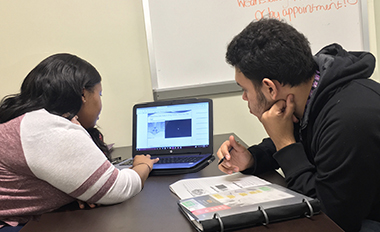A Helping Hand
 |
|
Peer educator Mariah Moody helps freshman Jonathan Acevedo prepare for a psychology test. (Photo by Jhoanna Haro) |
ALBANY, N.Y. (Nov. 14. 2016) — Freshman Jonathan Acevedo took notes about the effects of drugs on different parts of the brain, as senior Mariah Moody went over the material on a laptop.
Acevedo had been struggling in his psychology class, but was uncomfortable going to a professor for help. A classmate recommended he get some one-on-one tutoring from an upper classman through the Peer Educators Program.
It seems to be working. “You can relate more and you don’t feel pressured as much,” Acevedo said of working with a peer educator instead of a professor, which can sometimes feel “intimidating,” he said.
Moody, a senior psychology major and education minor, is putting her own coursework into action. She is one of more than 100 students in the Peer Education Program who assist students and professors by acting as tutors or lab assistants, helping with office hours and classroom management, or just meeting with students who need a hand to get through a course.
At the same time, the peer educators learn teaching and management techniques – and earn course credit.
Acevedo, who plans to major in digital forensics, is one of four students who meet with Moody on Wednesdays.
“The hardest part is trying to get the students to come to you because they don’t ask for help,” Moody said.
The program is available to all departments and Moody works through the Advisement Services Center. It’s her first semester as a peer educator.
The model has been growing and other programs, such as the Transfer Transition Leaders and the Writing Inquiry Program, also use students as peer educators, said Christine Smith, assistant dean for Professional Studies in the School of Education. And since 2012, there have been two formal courses recognizing the work peer educators do.
The educators used to get independent study for their work, according to Linda Krzykowski, assistant vice provost for student engagement. "We wanted to create something that would provide support for the peer educators, allow all departments to take advantage of this high engagement opportunity and would award credit that would reflect the learning that was being done."
What started as a pilot program in 2012 developed into two academic courses, an introductory and advanced level course in the Department Educational Administration and Policy Studies. The program has grown from eight peer educators to more than 100 in various departments.
“Faculty treat the peer educators like professionals, which builds a strong relationship,” Smith said. "They refer to us by first names because we trust them as a colleague and consider them colleagues."
Moody said being treated by faculty as an adult and a peer helps build mutual trust and respect. "It makes us feel better,” she said.
Ethan Sprissler, a lecturer of Information Technology Management, said he recruits peer educators to increase resources for his students. Last year he had more than 20 peer educators because of the number of students in his classes and the number of lab hours they needed to support.
The peer educators offer guidance, he said. “They can thoughtfully look at other students’ work and identify weak points and suggest improvement.”
Anne Hildreth, associate dean for Undergraduate Education and an associate professor in the Department of Political Science, said she noticed in a freshman seminar how effective the student-to-student connection was. The peer educator, she said “was more accessible and even got students involved in the groups on campus that he was a part of.”
Computer Engineering Lecturer Jonathan Muckell said the program is a great asset for him because his classes are large, which can make it hard to give enough attention to all students. Peer educators help by being available to answer questions and explain issues. “There is more support, allowing for a more engaging experience," he said.
Students have benefited through increased academic success, better retention and a better classroom experience, especially in the big lecture classes, said Richard Fogarty, associate dean for General Education and an associate professor in the History Department.
The experience is equally beneficial for the peer educators, Fogarty said. “They have applied learning opportunities and work with groups, which are important skills needed wherever they go.”
Muckell agreed, noting one peer educator who developed an interest in teaching.
Krzykowski said candidates for peer educators must be nominated by their departments. Her message to professors and department chairs: “Find the great students in your major and engage them in this program. It’s not only helpful to you but to the students in the lower level classes who need help and to the peer educators you work with through this wonderful program.”
![]() For more news, subscribe to UAlbany's RSS headline feeds
For more news, subscribe to UAlbany's RSS headline feeds
A comprehensive public research university, the University at Albany-SUNY offers more than 120 undergraduate majors and minors and 125 master's, doctoral and graduate certificate programs. UAlbany is a leader among all New York State colleges and universities in such diverse fields as atmospheric and environmental sciences, business, education, public health,health sciences, criminal justice, emergency preparedness, engineering and applied sciences, informatics, public administration, social welfare and sociology, taught by an extensive roster of faculty experts. It also offers expanded academic and research opportunities for students through an affiliation with Albany Law School. With a curriculum enhanced by 600 study-abroad opportunities, UAlbany launches great careers.


